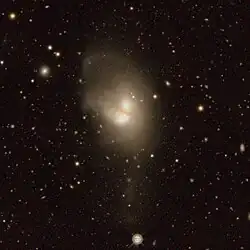| NGC 61 | |
|---|---|
 NGC 61A & NGC 61B (legacy surveys DR9) | |
| Observation data (J2000.0 epoch) | |
| Constellation | Cetus |
| Right ascension | -00h 16m 24.34s[1] |
| Declination | −06° 19′ 18.9″[1] |
| Heliocentric radial velocity | 7,946 ± 27 km/s[1] |
| Apparent magnitude (V) | 13.4 |
| Characteristics | |
| Type | S0 pec:[1] |
| Other designations | |
| MCG -01-01-062, PGC 1083[1] | |
| NGC 61B | |
|---|---|
| Observation data (J2000.0 epoch) | |
| Constellation | Cetus |
| Right ascension | 00h 16m 24.07s[2] |
| Declination | −06° 19′ 07.9″[2] |
| Heliocentric radial velocity | 8,152 ± 27 km/s[2] |
| Apparent magnitude (V) | 14.5 |
| Other designations | |
| MCG -01-01-063, PGC 1085[2] | |
NGC 61 is a pair of lenticular galaxies, NGC 61-A (or NGC 61-1) and NGC 61-B (or NGC 61-2) in the constellation Cetus. Both were discovered on September 10, 1785 by William Herschel.
References
External links
- NGC 61 on WikiSky: DSS2, SDSS, GALEX, IRAS, Hydrogen α, X-Ray, Astrophoto, Sky Map, Articles and images
- NASA/IPAC Extragalactic Database
- "NGC 61". SIMBAD. Centre de données astronomiques de Strasbourg.
- SEDS
This article is issued from Wikipedia. The text is licensed under Creative Commons - Attribution - Sharealike. Additional terms may apply for the media files.